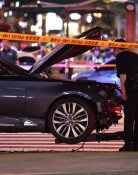Fears Rise Over Counterfeiting of New W50,000 Bill
Fears Rise Over Counterfeiting of New W50,000 Bill
Posted July. 01, 2009 05:04,
A week after the new 50,000 won (39 U.S. dollars) bill was put into circulation, a 28-year-old man in Incheon was arrested on the charge of producing and trying to spend counterfeit versions of the bills.
The government is on high alert over the counterfeiting of the country`s first high denomination bill in 36 years. The Bank of Korea, the Korea National Police Agency, the National Intelligence Service, Korea Minting and Security Printing Corp., the National Institute of Scientific Investigation, and the Korea Customs Service held yesterday working committee and technology consultation meetings on measures to prevent counterfeiting.
○ Coarse counterfeit bills
The most sophisticated counterfeit bills are those of the U.S. dollar. Even anti-counterfeit machines cannot identify fakes because forgers fabricate concealed silver lines that appear when put under light and color ink that changes color depending on viewing angle.
Ryu Il-nyeong of the minting corporation said, Unlike other counterfeit bills including the euro produced via simple printing, the U.S. dollar is forged through intaglio printing. Paper and ink are also almost identical to those used for genuine bills.
Comparatively, counterfeits of Korean bills are coarse and easily discernible to the naked eye since they are produced via color printers.
The most frequently fabricated bill is also the U.S. dollar. According to Korean intelligence, fake U.S. dollar bills worth 200 million dollars are detected every year and 620 billion dollars worth of the counterfeit notes are in circulation worldwide.
A rapid increase in fake bills is attributed to the widespread use of computers, scanners and multi-use printers. In Korea, the number of counterfeit bills increased from 3,000 in 2000 to 12,900 in 2005 to 21,900 in 2006 but the country has only 4.1 fake bills per million, lower than Britain with 136.2, Canada 83.2 and Europe 50.4.
○ Cutting-edge forgery devices
Fears are increasing, however, that international crime rings can target the 50,000 won bill. Given this, the central bank and the minting corporation have incorporated 23 anti-forgery features into the bill. A three-step method uses ordinary people to tell whether a bill is fake. If they cannot tell, a forgery detection machine is used and if that fails, experts use 10 of the 23 anti-forgery features.
The most remarkable prevention measure is the silver line called motion, a technology invented by a U.S. private company that has defied forgery. Sweden became the first country to adopt the measure in April 2006, Mexico followed suit last year, and Korea is now the third. The United States will also use the technology for new 100 dollar bills.
Experts, however, say counterfeiters can also copy the technology soon. The key to preventing counterfeiting is to develop technology ahead of criminals.
Ryu of the minting corporation said, The United States changes bill designs every six or seven years and adopts cutting-edge technology, adding, Korea also needs to issue bills that apply new designs and technology more often.
jaeyuna@donga.com







